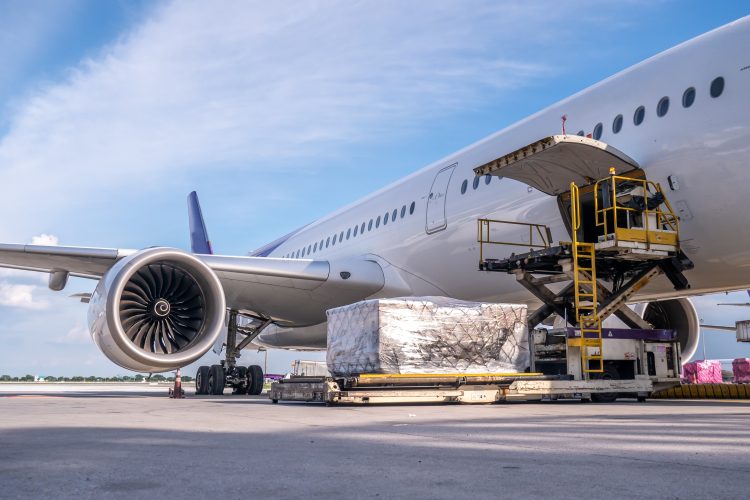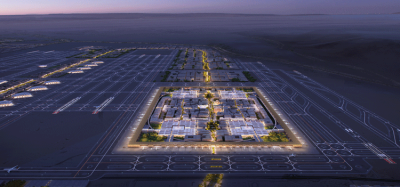The future of e-commerce, cargo and real estate at Edmonton International Airport
- Like
- Digg
- Del
- Tumblr
- VKontakte
- Buffer
- Love This
- Odnoklassniki
- Meneame
- Blogger
- Amazon
- Yahoo Mail
- Gmail
- AOL
- Newsvine
- HackerNews
- Evernote
- MySpace
- Mail.ru
- Viadeo
- Line
- Comments
- Yummly
- SMS
- Viber
- Telegram
- Subscribe
- Skype
- Facebook Messenger
- Kakao
- LiveJournal
- Yammer
- Edgar
- Fintel
- Mix
- Instapaper
- Copy Link
Posted: 16 September 2024 | Alex Lowe | No comments yet
For Issue 2 2024, Alex Lowe, Director of e-commerce, Cargo and Aviation Real Estate at Edmonton International Airport, spoke to International Airport Review at the Routes Asia 2024 conference in Langkawi, Malaysia about the airport’s ambitious cargo, real estate and air delivery-by-drone plans.


Prefer to listen to this article? Listen to the podcast
Please tell us a little bit about yourself and your role at Edmonton International Airport
I lead a team that looks after the cargo business at the airport as well as a few other areas of focus.
These areas are the air cargo network – the cargo that goes on and off. Our current serve our airport by growing the airlines from a cargo perspective, and by supporting long-haul passenger flights with cargo business.
The next area is what we call ‘the demand’; so working with people like freight forwarders or other industry players to grow the amount of cargo and help support our partners in terms of putting more cargo on their flights. This is a new business development.
We find new streams of cargo in our region or within our catchment area, again to help support our partners, because we’re invested in their success.
The other part of my job title – e-commerce – is a major area of focus for us. We believe that e-commerce will lead a lot of the cargo growth in the industry, but also for us in Edmonton.
The real estate part of my job is making sure that we have a solid frontline infrastructure. So, the aviation real estate side is airside warehousing and even cargo aprons and fuel hydrogen systems which are important for our cargo partners.
e-commerce can mean a few different things. What is it that you’re doing in this space?
Absolutely, e-commerce has become an umbrella term. During the pandemic we saw there was an opportunity for Edmonton to act as a gateway for e-commerce products for all of North America.
We were successful in landing a number of flights, specifically from China, but also from other parts of Asia where they carry e-commerce goods and offload in Edmonton. We also work with existing partners at the airport so they could interline or move cargo on their aircraft throughout Canada and even down into the United States.
When we think of e-commerce and what the opportunity looks like going forward, we’re big believers in the concept of e-freight. This is the electronic movement of cargo from end-to-end and throughout the journey. This means integrating all players in the supply chain, be it the airlines, the freight forwarders, the regulatory agencies like customs, etc., all into this concept of freight.
A lot of this is driven by consumers; when we order something online or when we transact with e-commerce, we want to know where our goods are, we want to see that the product is moving quickly and getting to us as fast as possible. Having that end-to-end visibility will hopefully be a unique selling point for us at the airport. Airport cargo and community systems have become a more broadly talked about topic lately for airports as a means of achieving that goal of end-to-end e-freight.
Are there any new trends that you are observing with your passengers and their spending habits in the e-commerce area?
Alberta is the fastest growing province in Canada by a healthy margin. The reason for that is that there are a lot of well-paying jobs available in Alberta and Albertans have a fair bit of disposable income, which bodes well for travel. Albertans have typically led Canada in terms of retail spend, on a per capita basis, for quite some time. Naturally that lends itself to a strong e-commerce in our region, which bodes well for our e-commerce growth at the airport as well.
What new features are you planning on introducing this year and in the future for your e-commerce?
We are in the midst of two major expansions, both partially funded by the federal government. The first is about halfway complete and we have expanded our cargo apron, doubled it in size and added 47,000sqm of dedicated cargo aircraft parking. This year, we’re adding a fuel hydrant system to both of our cargo aprons. In total, we can handle about 11 wide body freighters side-by-side in our now expanded cargo apron. The last component will be to expand our perishables handling. We handle and export a fair bit of pharmaceuticals and perishables from Edmonton, so we’ll be expanding the facilities needed to handle those types of commodities.
Our second project is an extremely ambitious project that we’re calling our international cargo hub, which is a CAD$300 million project converting roughly 2000 acres of greenfield at the airport strictly for cargo for logistics. Things like warehousing, frontline airside, ground side distribution, warehouses, to support the overall cargo business in the Edmonton region. We hope to start as soon as the ground thaws in Edmonton. As soon as that winter’s behind us, we’ll be looking to break ground on the international cargo hub. We’re really excited as that will be a modern development catering to e-commerce.
What has the cargo story been for Edmonton?
As devastating as the pandemic was for the world, for people and for the passenger side of aviation, we have benefited on the cargo side of our airport. When I talked earlier about that frontline infrastructure that we try to build, we try to be ahead of the demand. The result was that we were one of the few airports that had the infrastructure and capacity to handle the surge of goods that most of North America saw coming, particularly from China.
It started with personal protective equipment (PPE) such as masks and gowns and gloves; multiple daily flights from China; wide body freighters and it moved into vaccine test kits. But then this ultimately pivoted to e-commerce. And having that infrastructure kept people at the airport and kept everything going because of the PPE flights. Consequently, we were able to quickly pivot those resources to e-commerce and I think that differentiated us.
The key for most of the partners that we dealt with at that time was the speed. The aircraft was an asset that they wanted to be back in the air as quickly as possible. Edmonton differentiated itself by providing the guarantee that you’re going to get your cargo offloaded, that it would clear customs and that it would get to where it had to get to – whether that be an onward point or right in the Edmonton region for last mile delivery. This was a positive for us as the new relationships and carriers that served Edmonton have continued to service well.
But with that said, I’d be remiss if I didn’t mention we have seen cargo come back down to earth, so to speak. We had three record years of cargo growth culminating with our new all-time record tonnage number in 2022. 2023 has come back down to earth a little bit, but it wouldn’t have been realistic to expect that growth trend to continue on the level that it was, and it’s also a sign that consumers are switching back to more conventional retail shopping.
You must be predicting quite an uplift in the coming years or decades in cargo. Is that correct?
Absolutely, we were predicting this. We were bullish on cargo growth at our airport before the pandemic. The pandemic allowed us to turn on some of the infrastructure that we had been developing and show that we were making the right investments. This continues our belief and our drive towards growing our cargo business. We think there’s a lot of opportunity in the cargo space for Edmonton, given our geographical location as a northern airport (as we run along the circumpolar roots from both Asia and the EU). We also have the largest airport in Canada by land, so while some airports can be constrained in terms of cargo development, we don’t have that challenge.
How are you looking to grow your cargo division in the future?
We’re investing heavily in the infrastructure piece, as we know it’s critical to have the right infrastructure in place. I also think it’s important to note that with aviation and specifically cargo in the future, sustainability is becoming more and more key. We must become more sustainable as an industry. We’re making pretty significant investments on the sustainability side, which we do believe will help our cargo partners to achieve their sustainability goals. We’re about to start construction on the world’s largest solar farm at an airport. The new buildings will be solar-powered, making them green, and also offering some opportunities for electrification of ground support equipment and courier fleets (from solar power). Edmonton is also Canada’s hydrogen hub. Historically, Edmonton has been an oil and gas market and so a lot of the expertise that comes from that industry is now being pivoted and redeployed in the hydrogen economy.
As a hydrogen hub, we are looking at ways we can introduce hydrogen to airport operations and potentially to fuelling aircraft in the longer-term future. There’s some exciting stuff going on there; we purchased a fleet of Toyota Marai hydrogen-powered cars, which are deployed at our airport, and we’re looking to add hydrogen fuelling stations. We are also working with a few of the original equipment manufacturers (OEMs) in the hydrogen aircraft space as well. And as much as hydrogen is somewhat of a new technology, we also understand the importance of sustainable aviation fuel (SAF). We have a few MOUs in place with organisations looking to develop SAF for production or use at the airport as well.
Is SAF a big part of the conversation when you’re speaking with airlines at conferences like Routes?
Absolutely, and increasingly so. It’s notable how quickly the topic is gaining momentum. The typical conversation these days is around supply and demand, which must become more aligned. Supply is difficult, and therefore the price is high. We know as travellers, but also as cargo shippers, that people are price sensitive. As SAF becomes more widely adopted, this will regulate the price more, but we also have to respect that it may cost more in the short-term, and governments around the world are trying to support that. We absolutely want to play our part, we know it’s not going to be cheap and it’s not going to be easy, but we want to create that SAF infrastructure at our airport and to support our partners.
Any route has an origin and a destination, and if you can have SAF at both an origin and a destination, it will make that route that much more attractive to an airline. Certainly in time, airports being able to provide SAF will be a differentiator.
You’ve also been testing drone cargo deliveries, haven’t you?
Yes, this is a very important project for us, and we’ve just announced that we’re about to commence phase two of our drone project. We are really proud of this endeavour at our airport. As far as we know, we’re the only airport in North America, operating commercial drones in controlled airspace as all airports are. Our operations team have worked and continue to communicate tirelessly with the regulators, in our case that’s NAV Canada and Transport Canada, to essentially write the playbook for a new industry.
In short, we have a number of partners, Drone Delivery Canada, Air Canada Cargo and in our new phase, we’ve introduced Montana First Nations, BBE. We also have Apple Express. There’s a lot of different parts of the industry represented in this overall partnership.
It’s a drone that today carries about 10lbs and it flies every hour during the week on a prescribed route. This demonstrates to regulators that this can be done safely in and around an airport, carrying packages and delivering them to a drone spot at the other end of the route.
Now we’re getting into phase two, which will see the extension of the route to a medical centre delivering pharmaceuticals and medications to Montana First Nation’s clients. We are so excited about this as it’s groundbreaking stuff. Drones, electric vertical take-off and landing (eVTOL) and advanced air mobility in general, is another rapidly evolving space and it’s not one we’re scared of at our airport. We understand the need of always doing it safely and securely.
Do you think conferences like Routes could evolve in the future, with airlines attending as well as drone operators and eVTOL operators?
Absolutely. We look at drones or advanced air mobility (AAM) as another form of transportation. If you think of multimodal or different modes, road, rail, air, ocean, drones are another mode added to the list and certainly in the cargo space, I would say that’s already happening. In the large international cargo conferences we are seeing an increasing number of drone companies exhibiting, participating and presenting, because people want to hear about it and want to understand what’s going on.
Real estate is the third part of your job title and Edmonton has quite ambitious plans in terms of its airport city. Could you kind of explain a little bit about that part of your role and how you are developing in that area?
We’re very fortunate to have available to us considerable land area for cargo development, and we certainly believe that having the right type of infrastructure at the right time is going to lead to cargo growth. When it comes to the movement of cargo, it’s not always about getting as close as possible to the end users. People use air cargo for its speed, reliability and its safety and security.
It’s a more costly means of transporting goods, so if people are going to pay that higher cost, we want to do everything we can to ensure it moves smoothly, safely and quickly, all while maintaining visibility during the journey. As mentioned, we completed a cargo apron expansion, which if you think of the apron as the ocean, we have a considerable amount of ocean front now available for lease.
We’re working with a few of our largest partners on some new developments on those lots. And of course, we have our international cargo hub, which will be our next phase. Once we’ve broken ground there, we expect that project to move very quickly.
What are your challenges for this year?
Certainly on the cargo side, there has been a bit of a cooling down, so our partners are dealing with a slight downturn in demand. We want to work with them and understand where we can help and what those challenges might be. We’ve also heard about some supply chain challenges with new aircraft and shortages of resources like flight crew.
We’ve got a number of things happening at the airport that we think are geared towards helping our partners. One thing that we have is the AATC, the Alberta Aerospace and Technology Centre, which is really focused on education and training for the aviation industry. Whether it be pilots or air traffic controllers or other segments of the industry, we want to try to help in terms of bringing new people into the industry. We remain pretty encouraged about where we’re at. I think the passenger side of our business is now rebounded almost completely, which has created some great opportunities in the belly cargo space that was almost completely shut down for a while. Lots of reasons for optimism.
What are you most looking forward to this year?
In the short-term, we are really excited to launch phase two of our drone programme. We’re also in the process of re-certifying our IATA CEIV pharma accreditation. Three years ago, we got most of our ground handlers and some airlines and shippers certified collectively, and it’s gone really well. We’re really excited about the opportunities in pharmaceutical shipping that that accreditation has created.
Finally, I’m excited about some of these big infrastructure projects that I mentioned earlier. A lot of planning and time goes into it, so it’s really exciting to see three dimensional things coming out of the ground in terms of these developments, and just continuing to work with our airline partners to increase their service, whether that’s more flights, bigger aeroplanes, or new entrants altogether.
About the author
Alex Lowe is the Director for e-commerce, Cargo and Aviation Real Estate at Edmonton International Airport (YEG). Alex brings to this role more than 20 years of diverse experience in the aviation industry, the majority of which has been spent in the air cargo sector.
Alex develops and implements strategies to grow the airport’s air cargo network domestically and internationally while ensuring the airport is building the needed infrastructure and capacity to facilitate YEG’s growth as a gateway for e-commerce and global logistics.
Alex and the team at YEG are committed to growing the airport’s business in a sustainable and responsible way and have become industry leaders in the adoption of sustainability initiatives and innovative technologies.
Prior to joining Edmonton International Airport, Alex spent 13 years at Cargojet in a regional management capacity.


















